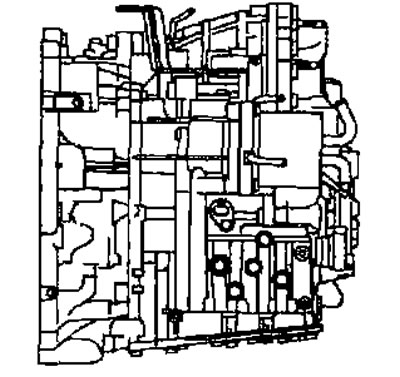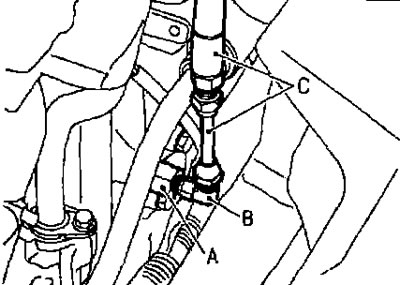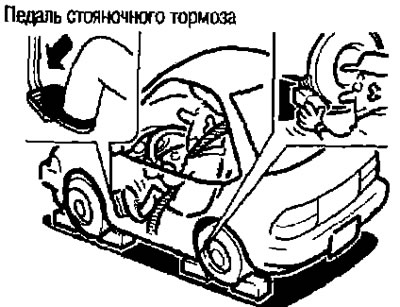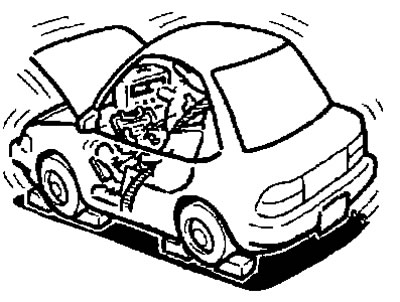
Main Line Pressure Check Procedure
1. Check the engine oil level and add if necessary.
2. Drive the car for about 10 minutes and warm up the CVT fluid to 50-80°C, then check the CVT fluid level and add if necessary.
3. After the CVT fluid has warmed up, remove the plug from the inspection hole to check the pressure and connect the pipe adapter (special tool: KV31103600) (A), adapter (special tool: 25054000) (IN), oil pressure gauge (suitable special tools) (WITH).

Attention. When using an oil pressure gauge, install the O-ring from the inspection hole plug.
4. Apply the parking brake securely so that the wheels do not rotate both at idle speed and at stationary vehicle speed.

5. Start the engine and measure the pressure in the main line, both at idle speed and at stationary vehicle speed.

Attention:
- When taking measurements, keep the brake pedal pressed all the way.
- When measuring the pressure in the main line at the speed of a stationary vehicle, see paragraph above. «Checking with a stationary vehicle».
6. When the measurement is complete, replace the pressure test plug and tighten to the specified torque.
Attention:
- Do not reuse the O-ring.
- Apply CVT fluid to the O-ring.
kPa (kg/cm²)
| Engine speed | Main line pressure |
| Provisions «R», «D» and «L» *1 | |
| At idle speed. | 750 (7,65) |
| At the speed of a stationary car | 5700 (58 14) *2 |
*1: In sport mode
*2: Standard values
Evaluation of the results of checking the pressure in the main line
| Result | Probable Cause | |
| At rpm x. X. | Low pressure in all positions («P» «R» «N» «D» «L» *) | Possible causes include disturbances in the pressure supply system and a decrease in the performance of the oil pump. For example: |
| • worn oil pump | ||
| • the pressure control valve or plug is stuck or there is spring fatigue | ||
| • oil leak in the chain «oil pre-filter → oil deposits → pressure regulating valve»; | ||
| • idle speed too low. | ||
| Low pressure in only one of the positions | Possible causes include oil pressure leaking in the passage or device associated with this position after applying pressure from the range valve | |
| High blood pressure | Possible causes include a malfunction of the sensor or irregularities in pressure regulation in the main line. For example: | |
| • deviation of the accelerator pedal position signal; | ||
| • the CVT fluid temperature sensor is faulty; | ||
| • solenoid valve is faulty «A» pressure regulation in the main line (stuck when turned off, clogged filter or rupture in the line); | ||
| • the pressure regulating valve or plug is stuck. | ||
| At the speed of a stationary car | The oil pressure does not rise higher than the pressure at rpm x. X. | Possible causes include a malfunction of the sensor or irregularities in pressure regulation in the main line. For example: |
| • deviation of the accelerator pedal position signal; | ||
| • the TCM unit is faulty; | ||
| • solenoid valve is faulty «A» pressure regulation in the main line (short circuit, stuck when switched on); | ||
| • the pressure control valve or plug is stuck. | ||
| Blood pressure rises, but does not reach normal levels | Among the possible causes are violations in the pressure supply system or in the pressure regulation in the main line. For example: | |
| • deviation of the accelerator pedal position signal; | ||
| • solenoid valve is faulty «A» pressure regulation in the main line (stuck, clogged filter); | ||
| • the pressure control valve or plug is stuck. | ||
| Low pressure in only one of the positions | Possible causes include oil pressure leaking in the passage or device associated with this position after pressure is applied from the range valve. | |
* In sports mode.